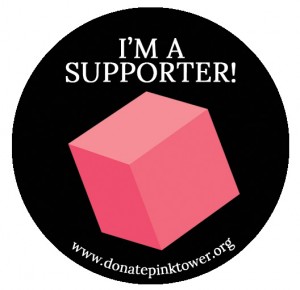
From Kickstarter to Indiegogo–a tale of two different campaigns
Today’s guest blogger, Jan Selby, is in the midst of running her second crowdfunding campaign. Taking the lessons she learned from prior fundraising on Kickstarter, she is using Indiegogo this time. Find out why the switch?
Crowdfunding is not for the faint of heart. It requires months of planning, hard work, and follow-up. It’s worth it if you are prepared and motivated. I’ve launched two campaigns for feature-length documentary films and found them to be powerful strategic tools to help build a community and raise money.
Sheri asked me to summarize what I’ve learned through one successful Kickstarter campaign and a second Indiegogo campaign (currently in progress). I’ve tried to pack as much as I could in this post to share what I’ve learned. I’m not an expert, but I hope my experiences will be helpful to you as you embark on your own crowd-funding journey.
My first bit of advice is to create a team who will work with you for 6 months – 3 months before you launch, then during and after your campaign. I’m a detail-oriented planner by nature. If you’re not, find someone who is and make him/her part of your team. It’s important to avoid launching your campaign until you are fully prepared. Do all you can to be ready before you launch because you’ll be incredibly busy during your campaign.
How long should your campaign be? Most campaigns do best in the first and last week. As one friend told me, “The longer your campaign, the longer your time of suffering in the middle!” I like having a week or so to spread the word about the campaign before the 30-day countdown begins. I also plan to use the first few days to work out the kinks that are inevitable, no matter how hard you planned ahead.
Campaign 1: Kickstarter
My first campaign raised $21,112 to complete my first feature documentary, 9 Pieces of Peace (working title). You can check out the campaign home page at the URL www.9piecesfilm.com/fund. Notice this URL is not the one we were assigned by Kickstarter. Create your own URL that is easy to remember and that you can use after your campaign ends. Research how to redirect your new URL to the Kickstarter URL and then you can choose what to do with it after the campaign ends. I’ve kept it directed to our Kickstarter page, but you could also redirect it to a “Donate” page on your film website.
There are three core elements of a crowdfunding campaign home page. Before you launch, you will need:
1. A pitch video/film trailer
Having both a pitch and film trailer is important if you can swing it. It’s great if the production quality can reflect your capabilities and your vision for the film, but don’t obsess over it if it can’t. Be creative and speak from the heart. Mine weren’t as good as the film will be, but they worked. Consider combining them as I ended up doing in my second campaign.
2. Well-designed rewards
Take the time to research what others have done. Carefully calculate the direct and indirect costs to deliver each reward (including the fees you will pay to the platform and the credit card processor), including shipping and your time. Add 3 to 6 months to when you think you can deliver the reward because everything takes longer than you expect. You can’t change the reward description once someone has given at that level, so be sure to add all the details. Leave room to add new levels. Be thoughtful about the language you use and be consistent. For our Kickstarter campaign, we chose to use the words “backer” and “supporter” plus “rewards” and “pledges”. (For my second campaign on Indiegogo, we are using “donors” and “perks,” but it’s a very different film and campaign.)
3. Well-written text.
Write text that tells your story, builds trust, and motivates the reader to want to be part of the community that makes your film happen. Use subheads to break up the text and add images/graphics to make it more interesting. Remember that MANY people have no idea about how crowdfunding works, so write text for an audience that doesn’t understand it. You can change the text of your page during the campaign, but not once it’s over, so be sure you are happy with the way it looks at the end of your campaign.
Once you have your home page content defined, you might think you are ready to launch. Not yet. Here’s a partial list of what I recommend you and your team do before you launch your campaign.
Network Build up your community of followers on all your social media channels (if you don’t have them, get them), build an email list, network with organizations whose members would want your film to be made, and create a media list to use during the campaign. Meet with anyone who might be interested before and during the campaign.
Develop content and plan promotions Develop your page content, design an e-blast/e-newsletter template, design and print postcards, design a flyer that you and others can post, define your social media messaging calendar and graphics/clips/quotes/images (we used Facebook, Twitter, Pinterest, and Google+), create a graphic that tracks your fundraising progress and plan to use it to update your Facebook cover image daily, define your online advertising campaign strategy (we created and analyzed Facebook and Google ads), define thank-you surprises for supporter updates, and define incentives that you’ll use to entice prospective supporters (our Kickstarter page highlights the last one we did at the top of it).
Get lots of sleep.
Once you launch your campaign, your priority will be communication. Kickstarter (and other platforms) are designed for social media users. Yet, to maximize your chances of success, you need to reach beyond these boundaries.
I sent private Facebook messages to hundreds of people and this worked incredibly well. I also sent hundreds of email messages out to friends who don’t use Facebook and had never heard of Kickstarter. Each message briefly explained the campaign, the status of it, and a request to either contribute or spread the word. Our team distributed thousands of postcards that directed people to our Kickstarter page and emphasized the purpose of the film and the “all or nothing” aspect of the campaign to create a sense of urgency (which was real!). I set up coffee/lunch/drink meetings with friends, turning them into evangelists and sending them off with stacks of postcards.
Remember to continually thank your growing list of supporters! Most platforms make it easy to send out updates. Your supporters want to hear from you. They are also your best advocates. They are invested in your campaign in more ways than one. If you can keep them energized, they will continue to share it.
Communication is time consuming, whether it is online, by phone, or in person. Your team can help in many ways. Together, your goal is to expand your reach as far as possible to people who will care about your project. You never know where your money will come from. Sure, there will be low hanging fruit, but I was shocked when my largest contribution came in on THE LAST DAY from someone whom I hadn’t seen for a year, but who had been following the campaign the whole time, unbeknownst to me.
Overall, our Kickstarter 9 Pieces of Peace campaign was a resounding success, but I must admit, it was very stressful. It was hard for me to sleep or relax for the entire 39 days (and 936 hours). I kept thinking: How would I forgive myself if I didn’t reach my goal because I hadn’t worked hard enough? (Yes. Very type A. Can’t help it. Born that way.) Was I happy with the results? Definitely! The moment I saw online that I had reached my goal, I unexpectedly burst out crying. I think it was a combination of the joy of reaching my goal and the relief that it was over. It’s important to be honest with yourself about if you and your team are up to the challenge.
Campaign 2: Indiegogo
When it was time to launch my second crowdfunding campaign for a documentary film about the transformative power of Montessori education, Building the Pink Tower (working title), I wanted to try a different approach. To be perfectly honest, I was still burned out on the stress of an all or nothing Kickstarter campaign a year later and didn’t know if I wanted to take on that level of intensity again. But my co-producer/co-director, Vina Kay, and I chose Indiegogo because we felt it was a better match for our film.
If you conduct more than one crowd funding campaign, you may be able to build upon the community of supporters you establish with each one. For me, there wasn’t much overlap between the two audiences (except for a few family and friends).
It’s important to think about niche audiences for your film and use this information to create a strategy for your campaign. For this crowd funding campaign, we have the opportunity to tap into an existing group of supporters. There is an established Montessori network – people who love it because they have had a direct experience with it either as a student, parent, or teacher. Vina and I spent the last two years learning about and connecting with this Montessori infrastructure in the U.S. and beyond. Our fundraising trailer had been viewed more than 15,000 times on You Tube, and a short video we created that reflected the vision for our film had been viewed more than 50,000 times.
Our current goal of $50,000 is high, but we feel we have the potential to reach it with the support of this passionate Montessori community. We had secured challenge grants of $20,000 as an added incentive to help us reach our goal. Most importantly, although we are optimistic, we want to be able to keep the money raised if we fall short of our goal. For these reasons, we felt Indiegogo was the best platform for this campaign.
In addition to what we did for our Kickstarter campaign, here’s a list of a few more tricks we are trying on this campaign:
-We created fewer “perk” levels and designed them to minimize our expenses; we combined our pitch and trailer into one video; we created a digital image that “donors” could use as their Facebook profile photo; we created photo/quote graphics that are popular reposts on Facebook; and we have paid to “boost” posts on Facebook with strong results.
-In addition, we have created opportunities to have our campaign mentioned in Montessori media, at national conferences, and in school newsletters.
-We are also grateful to be working with a public relations expert who is donating her time to help us explore how we can attract the attention of the local and national media.
One last topic that is important to consider for any crowd funding campaign is whether a donation is tax-deductible. Both of my films have a fiscal sponsor (IFP MN). This allows donations made through the fiscal sponsor to be tax deductible. This means that when a donation is made through Kickstarter or Indiegogo, it isn’t tax-deductible. Many people won’t care about this, but a few do. We have handled this by having a brief mention on our Indiegogo home page with a link to our fiscal sponsor donation page. Donations made through this page do not count toward our Indiegogo goal. I have since learned that there is at least one fiscal sponsor, Fractured Atlas, who has a relationship with two platforms (Indiegogo and RocketHub) that will allow donations to be tax-deductible. It would be worth looking into whether you can gain fiscal sponsorship. [ed. It can take time to qualify, so do this long before you launch a campaign].
Our Building the Pink Tower Indiegogo campaign ends on December 18th. To follow our progress, visit www.donatepinktower.org. If you know anyone who has been touched by Montessori education, please share our campaign with him or her. We are committed to making a film that will change the national education debate. (Thank you!).
I wish you the best of luck in your crowd funding endeavors. I hope sharing what I’ve learned so far will contribute to your future success!
Jan Selby is a multiple regional EMMY© award-winning producer, director, and founder of Quiet Island Films, a full-service video production company with national clients. After 25 years in corporate marketing, Jan followed her heart to become a filmmaker and video producer/director. Follow Building the Pink Tower on Facebook, Twitter and add them to your circle on G+
Sheri Candler November 21st, 2013
Posted In: crowdfunding
Tags: 9 Pieces of Peace, Building the Pink Tower, campaign text, crowdfunding, Facebook, fiscal sponsorship, Google Plus, indiegogo, Jan Selby, Kickstarter, Montessori, network, perks, Pinterest, Pitch video, promotion plan, rewards, Twitter, Vina Kay, YouTube
Introducing TFC’s new fiscal sponsorship program
The Film Collaborative recently started a fiscal sponsorship program to help filmmakers get access to funds they would not be able to obtain without 501c(3) status. The program is now fully up and running, headed by Lynnette Gryseels, former Fiscal Sponsorship Director at Film Arts Foundation in San Francisco. We have been getting lots of questions from interested filmmakers so here are the answers to many of them. There is also a lot of information available on our website.
What is fiscal sponsorship and how does it benefit artists?
Fiscal Sponsorship is used primarily when a non-profit film/video project or event wants to secure funding from private, foundation, government or corporate sources that give only to nonprofit organizations with IRS tax-exempt status. To be considered exempt, an organization must hold a current 501(c)(3) certificate from the IRS.
What are the benefits to the filmmaker that they couldn’t do on their own?
Many funding opportunities are not available without tax exempt 501(c)(3) status
What does TFC look for in projects to grant fiscal representation?
Projects must be consistent with the Film Collaborative’s charitable purposes. This means that any project you are proposing must be noncommercial and represent an imaginative contribution to the film or video art form. Project can NOT be a “work for hire.” Once that criteria is met, we look for projects that are well thought out and have a good chance of getting funding and being completed. Prior filmmaking experience is helpful or if you are new, it helps to have a production team of experienced people; an advisory board with experience mentors is helpful as well and will help make up for a lack of experience with new filmmakers. A polished proposal is essential. Send us your best effort following the directions and if your project looks promising, we will help guide you to develop your proposal further.
If I apply, am I guaranteed to get accepted?
No. The Film Collaborative is not obliged to supply fiscal sponsorship. We will sponsor projects that are in alignment with the TFC mission and have strong, fundable applications. When we agree to become your fiscal sponsor, we are allowing you to use the TFC name to show support for your film. Therefore, we will only approve a project when the proposal is ready to be submitted to funders.
Is it only for US citizens or those operating within the US?
You do not need to live in the United States or be a citizen to apply for fiscal sponsorship. As long as one of your project’s named project directors has Social Security Number (SSN), Employer Identification Number (EIN), Independent Taxpayer Identification Number (ITIN) or other type of IRS registration. See the IRS for more information on obtaining the correct tax registration for non-residents.
Does one have to be a member of TFC to apply?
Yes. Applicants need to be a TFC member at the minimum Contributor level. See http://www.thefilmcollaborative.org/join.html to sign up.
How does one qualify?
To qualify, you must have
-A film project; documentary, narrative or short in any stage of production;
-You must join the Film Collaborative at the Contributor level or higher;
-Your project must be consistent with the Film Collaborative charitable purposes, is noncommercial and/or educational and represents an imaginative contribution to the film or video art form;
-The project may not be “work for hire”;
-You must be seeking donations in the form of grants from public agencies, foundations, corporations, or individual donors including fundraising benefits.
What is the submission process?
1. Join The Film Collaborative;
2. Pay the $35 fiscal sponsorship application fee;
3. Fill out and submit the online application form, and upload a PDF of your project proposal.
The application you submit to the Film Collaborative will also serve as a blueprint that you will use to secure funding by applying for grants or present to prospective contributors. Our goal is to help you build the best possible proposal in order to go forward and successfully raise the necessary funds to realize your project. Therefore, we accept projects with proposals that are ready to go.
What is the submission deadline?
There are no submission deadlines. Applications are open.
After I receive backing from TFC, what happens?
Once accepted, we will send you a copy of the Fiscal Sponsorship contract, a W9 form, a welcome package which includes a fiscal sponsorship support letter, tax ID number, a copy of your signed contract and information on how to set up online donations. Donors to your project can contribute online using a credit card or write checks to the Film Collaborative. Donations will be disbursed at the end of each month.
Once your project is accepted you can now apply for funds from public agencies, foundations, corporations, or individual donors. TFC will provide you with the necessary documentation to show that your project is fiscally sponsored.
Can I apply to the NEA, NEH, NSF or other government agencies?
The Film Collaborative cannot submit applications on filmmakers’ behalf to the National Endowment for the Arts (NEA), National Endowment for the Humanities (NEH) and National Science Foundation (NSF). Ask us about all other government agencies.
What are the administrative fees involved and what do they pay for?
Applicants must join the TFC and pay a $35 non-refundable application fee. After that TFC takes 5% of funds donated to your project. These fees pay for overhead such as staff time processing applications and donations.
Is there a reporting process?
Yes. You must report to TFC twice a year on all funds received for your project, monies spent and any significant budget changes. Failure to comply with the reporting process will result in project termination.
Does TFC provide advice on contacting donors and soliciting funding?
We can provide some advice and answer questions. You are responsible for applying for your own funds and sourcing your own donors.
Is there a difference between this service and others like Fractured Atlas?
Yes. TFC only sponsors film projects, Fractured Atlas sponsors many other types of projects in addition to film. The 5% TFC fee is the lowest of any known film project fiscal sponsor.
How long does the fiscal sponsorship stay active?
Your fiscal sponsorship will remain active as long as your reports to the TFC are up to date and you are still working on your film. Projects that fall behind on reports will be terminated and will require a fee to reinstate. Any funds donated to a dormant or terminated project cannot be dispersed until the project reporting is brought up to date.
Is the TFC fiscal sponsorship program exclusive?
Yes and no. Your project can have another fiscal sponsor that is not a film project fiscal sponsor, for example, a community organization or something related to your project is fine.
Can name changes or change of control happen under the sponsorship?
Yes, on a case by case basis, depending on the change required. Please ask.
Can I change my project or have more than one project entered into the program?
Depending on the nature of the change it may be considered a new project. Multiple projects by one filmmaker are possible.
What is your background with fiscal sponsorship/grant funding applications?
The TFC fiscal sponsorship program is headed by the former director of fiscal sponsorship at the Film Arts Foundation in San Francisco. We are used to reviewing proposals, have relationships with funders and can advise you on creating an attractive funding application.
Lynnette is passionate about film and helping filmmakers tell thought-provoking stories that entertain, assist social change and support their filmmaking aspirations. She has over 15 years experience working with independent filmmakers, non-profit film organizations and several local and international film festivals. She has previously assisted filmmakers in learning their craft through educational program development and project development support. At Film Arts Foundation in San Francisco Lynnette headed the Fiscal Sponsorship and Grants Program, one of the oldest fiscal sponsorship programs in the country. She brings a depth of knowledge from this experience to her role as head of TFC’s fiscal sponsorship program.
Orly Ravid July 3rd, 2012
Posted In: fiscal sponsorship
Tags: 501c3, charitable contribution, documentary, donors, financial reporting, fiscal sponsorship, Fractured Atlas, grants, independent film, Lynnette Gryseels, non profit, noncommercial, private funding, tax exempt, The Film Collaborative



